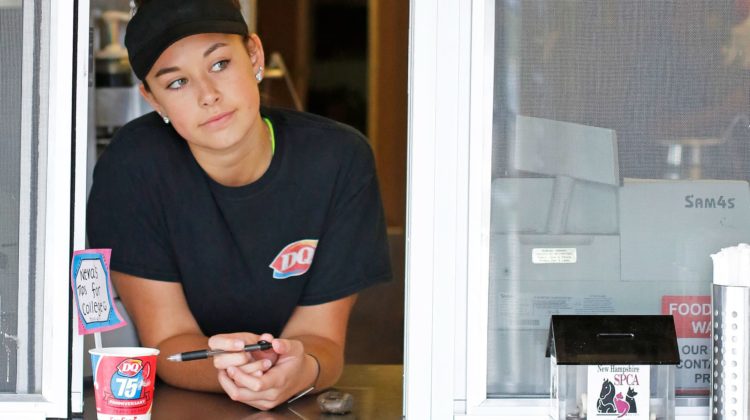
If a student invested $1,300 in Netflix stock in 2014, after three years they would have $4,527.
Jill Brady | Portland Press Herald | Getty Images
Teenagers haven’t had a better summer for employment since 1953.
In June, the unemployment rate for teenagers aged 16 to 19 was 9.9%, the lowest it has been since 1953, according to data from the Bureau of Labor Statistics.
A combination of post-coronavirus pandemic factors has led to the jump in teen hiring, according to Alicia Modestino, an economist and professor at Northeastern University in Boston.
Older workers who were laid off during the coronavirus pandemic may still be getting unemployment benefits or may no longer want the jobs they previously had — the strongest employment gains have been in fields that can hire teens, such as retail and restaurants.
More from Invest in You:
How to discover your best spending rate in retirement
Child care costs, lack of paid leave are holding back many working parents
What you need to know before starting to invest
“You have all these workers hesitant to go back, but employers are desperate to hire because it’s summer,” she said. This means many employers are turning to teenagers — they’re eager to work, generally don’t need benefits and will usually accept lower wages.
To be sure, the recovery in teen employment isn’t equal across the board, highlighting an uneven rebound from the coronavirus pandemic. While the unemployment rate for white teens was 9% in June, the rate was 9.3% for Black teens and 13.2% for Hispanic teens.
Still, for the youth that are working this summer, it is a golden opportunity to learn personal finance basics and start building wealth.
“The beauty of it, especially from a parent’s standpoint, is you have the opportunity to build habits from a young age,” said certified financial planner Tom Henske, a financial advisor with Fifth Avenue Financial in New York.
Financial experts recommend beginning with the basics of banking, saving and investing if you have teens who are working summer jobs. Getting a jump on these things can have a great impact on the rest of their financial life.
Establish a banking relationship
When one of your children starts earning their own money, a good place to start is to get them a banking relationship, said Henske.
This means setting them up with a checking or savings account, he said. He also recommends they have a debit card.
Many banks, credit unions and other financial firms offer low or no-cost accounts for the youngest customers. Some are specifically geared towards teens and come with opportunities to invest, as well as debit cards.
Having a savings and checking account set up for your teen helps them start thinking about where the money they’re getting from work is going.
Make a budget
Once you’ve helped your teen establish a banking relationship, it’s time to talk about budgeting.
For many kids, having a summer job is the first opportunity they’ve had with their own money to spend. Parents can help them establish good habits by giving them certain financial responsibilities, such as filling up the car with gas, paying for their own social outings or buying their own clothes with their new earnings, according to Henske.
This helps young people learn the value of money and how to distinguish between wants and needs, he said.
Open a Roth IRA
If your teen has earned income — meaning that they’re working at a job where they’re paying taxes on their wages, as opposed to being paid under the table — they are eligible to open a Roth individual retirement account.
This kind of IRA is a great way to start investing and save for the future. And, opening one as a young adult can give your teen a jumpstart on building their own personal wealth.
In 2021, a teen can put $6,000 in a Roth IRA, which will grow tax-free. They can also withdraw any of the money they put in without penalty, though if they wanted to take out any earnings, there would be a fine.
It’s important to highlight to teens that they can access what money they’ve put into a Roth IRA without penalty, according to personal finance expert Suze Orman.
“If they’ve saved this money and then they want to buy something with it and you say no, they’ll stop saving,” said Orman during a June CNBC + Acorns Invest in Pride: Ready. Set. Grow event.
Henske has another approach for incentivizing your teens to save in a retirement account and to take advantage of other financial tools later — you can match the amount your teen has set aside for the account.
“They’re going to know when they start their first job after college, when the 401(k) sign up comes around that they’re supposed to put money in because there’s a match,” said Henske.
Once your teen has started saving in a Roth IRA, they can also start investing through the account. Orman suggests guiding your teen through investing and learning about their different options together.
Henske agrees that dialogue is important and cautions that parents don’t have to know everything about money. It can be something you learn about together, he said.
Of course, there is always risk when it comes to investing in the stock market. But, according to both Orman and Henske, making mistakes early when the stakes are relatively low is a great way for your teen to learn investing best practices.
“Let them make mistakes when they’re younger and let them have autonomy with their money,” said Orman.
SIGN UP: Money 101 is an 8-week learning course to financial freedom, delivered weekly to your inbox.
CHECK OUT: How to make money with creative side hustles, from people who earn thousands on sites like Etsy and Twitch via Grow with Acorns+CNBC.
Disclosure: NBCUniversal and Comcast Ventures are investors in Acorns.
